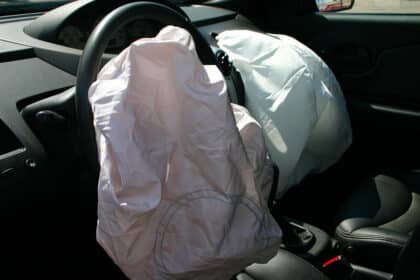 Photo: The News Wheel
Photo: The News Wheel
Being involved in a car accident can be really nerve-wracking, especially if you’re dealing with major vehicular damage or personal injury. To add to the stress, you must go through the process of submitting a claim with your car insurance provider — a process that can be time-consuming and very inconvenient. Learn how to make a claim with your car insurance company so you are prepared if the worst happens.
Safe Driving: The 2021 Chevy Traverse is packed with the latest safety tech
 Photo: Junior Libby
Photo: Junior Libby
Even after a minor car accident, it’s a good idea to file a police report. Your insurance company will likely ask you for a police report number, and the easiest way to get one is to have the police come to the scene and file a report. Otherwise, you may need to go to the police station after the fact to file the report, and you’ll be relying on your memory of what happened.

Your insurance documentation should list contact information for filing a claim. Call that number to initiate the process with your agent or insurer. You may also be able to initiate the claim through an online form and have an agent call you directly.
Be prepared to provide the following information:
- Policy number.
- Date of the accident.
- Location of the accident.
- Description of how the accident occurred.
- Name, address, license plate, and insurance information for the other party involved.
- Contact info of any witnesses.
- Name of the police department involved (if applicable).
- Police report number (if applicable).
Once you have started the claim, your agent will provide you with a claim number. Write this down and keep it in a safe place so you can refer to it when needed in the future.
There are several questions you should ask your insurer when filing your claim. The following video is a good place to start to make sure you cover all your bases.

After your claim is started, your insurance provider will assign a claims professional, also called an adjuster, to work with you on the claim. The adjuster will be your representative that works with the other driver’s insurance company, if applicable, and any other third parties that are involved.
Your adjuster will also work to get an estimate for the repairs to your vehicle. The insurance company may have agreements in place with certain garages that offer a discount and guarantee their work. While they cannot require that you use a mechanic of their choosing, they may ask for a second estimate if one you provide from your chosen repair shop seems too high.
If the accident spurred any personal injury claims, the adjuster will also review those on your behalf and work to resolve them.
 Photo: 401(K) 2012
Photo: 401(K) 2012
Once all the boxes have been checked by the insurance adjuster, they will let you know when and how your payment will be made (and how much it will be). They may pay the repair shop directly, or they may issue a payment to you instead.
Interior Comfort: The Buick Envision is hailed for its excellent interior by Autotrader
If your car has been damaged beyond repair (i.e. totaled), your insurance company will give you a check for the cash value of the vehicle. This won’t match the amount you paid for the car when you got it; it’ll pay out the car’s depreciated value so you can replace it with something similar. Of course, you can always add in some of your own money if you want to get a newer car than the one that was totaled.
Your state commissioner can help if you are experiencing issues or delays with your claim that aren’t being resolved.

After a car accident, the insurance adjuster will work to determine which driver was at fault. To do that, they look at the details of the accident to see what the main cause was. If you rear-end someone at a stop sign, you’re most likely going to be found at fault. But in some cases, the adjuster may assign a percentage of the fault to each driver.
Most states have laws that require the at-fault driver’s insurance to cover all car insurance claims after an accident. But 12 states are considered “no fault,” which means you will need to file personal injury claims with your own insurance company, regardless of who was at fault. In these states, the at-fault driver’s insurance would still be responsible for repair claims for all parties involved.
The 12 states with no-fault insurance are:
- Florida
- Hawaii
- Kansas
- Kentucky
- Massachusetts
- Michigan
- Minnesota
- New York
- North Dakota
- Texas
- Utah
- Washington
If you are ever in a car accident, it’s a good idea to be prepared in knowing how to file an insurance claim.
Catherine Hiles (she/her) is a native Brit living and working in Dayton, Ohio. Cat has written about a variety of subjects, including finance, cars, and parenting. She is a frequent contributor to Dayton Mom Collective, The Penny Hoarder, and WDW Magazine.
Cat lives with her husband, their two kids, and their energetic pitbull mix. She counts running, lifting weights, walking, and reading among her hobbies. See more articles by Cat.









